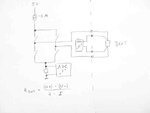Ashkar
Full Member level 2
Hey,
I am little worried about thermocouple effect.
How would I calculate the thermocouple effect in conductors / DUT
Any formulas available.
Now looking onto the following cons and pros for each systems
Looking into the DC exited system we will require a zero drift opamp with high gain single ended 18 bit/16 bit ADC
single ended 18 bit/16 bit ADC  a display unit
a display unit
And now looking onto AC exited we have zero drift opamp Bipolar adc
Bipolar adc  display unit.
display unit.
That's pretty straight forward.
But both of the excitation techniques have their pros and cons.
Like Ac ➡ inductive effect and skin effect
And DC ➡ thermocouple effect
I am little worried about thermocouple effect.
How would I calculate the thermocouple effect in conductors / DUT
Any formulas available.
Now looking onto the following cons and pros for each systems
Looking into the DC exited system we will require a zero drift opamp with high gain
And now looking onto AC exited we have zero drift opamp
That's pretty straight forward.
But both of the excitation techniques have their pros and cons.
Like Ac ➡ inductive effect and skin effect
And DC ➡ thermocouple effect

![15198-figure_1[1].jpg 15198-figure_1[1].jpg](https://www.edaboard.com/data/attachments/44/44961-92311155fb0ca6412547b85ac2f826bb.jpg)
![15198-figure_1[1].jpg](/data/attachments/44/44960-d480b586d631b2f3be5e9f25ef78cf60.jpg)